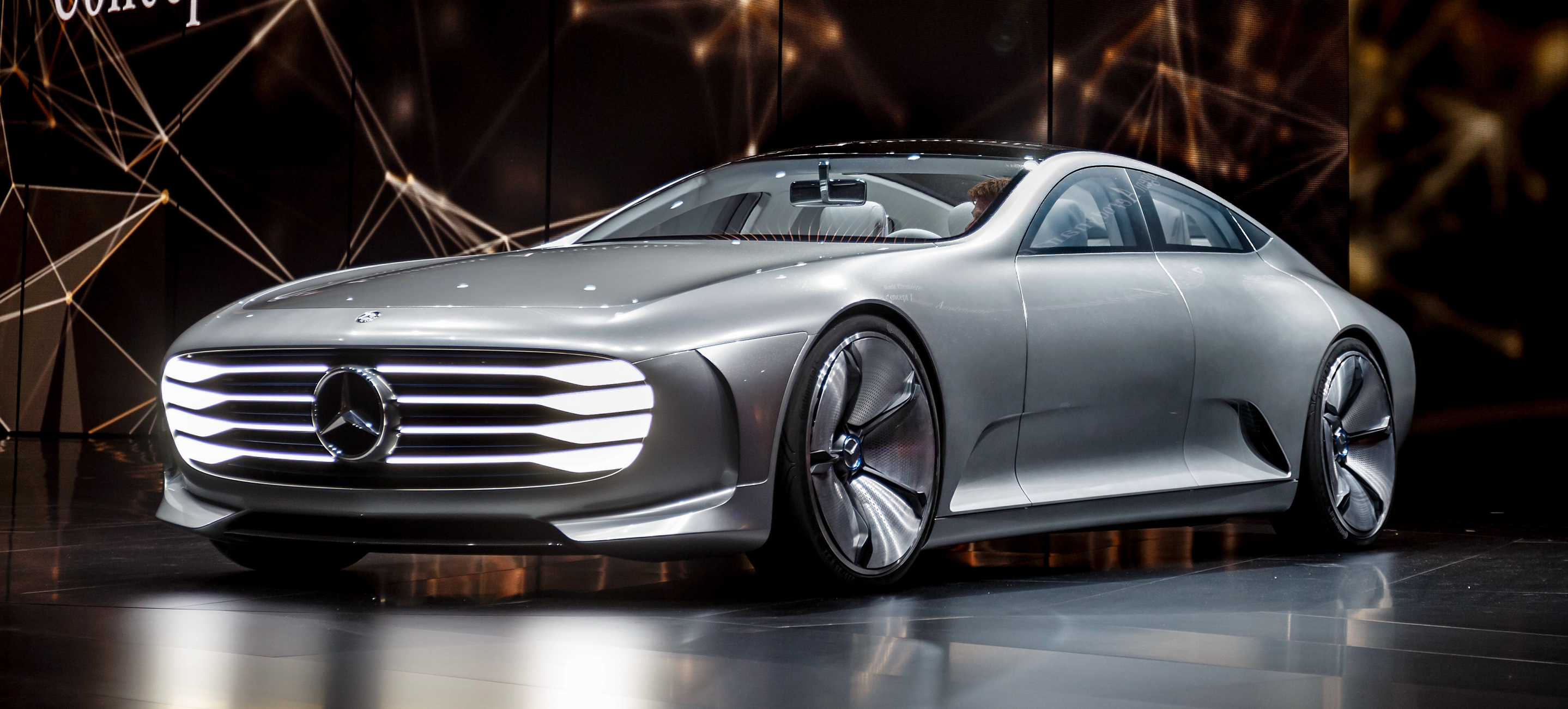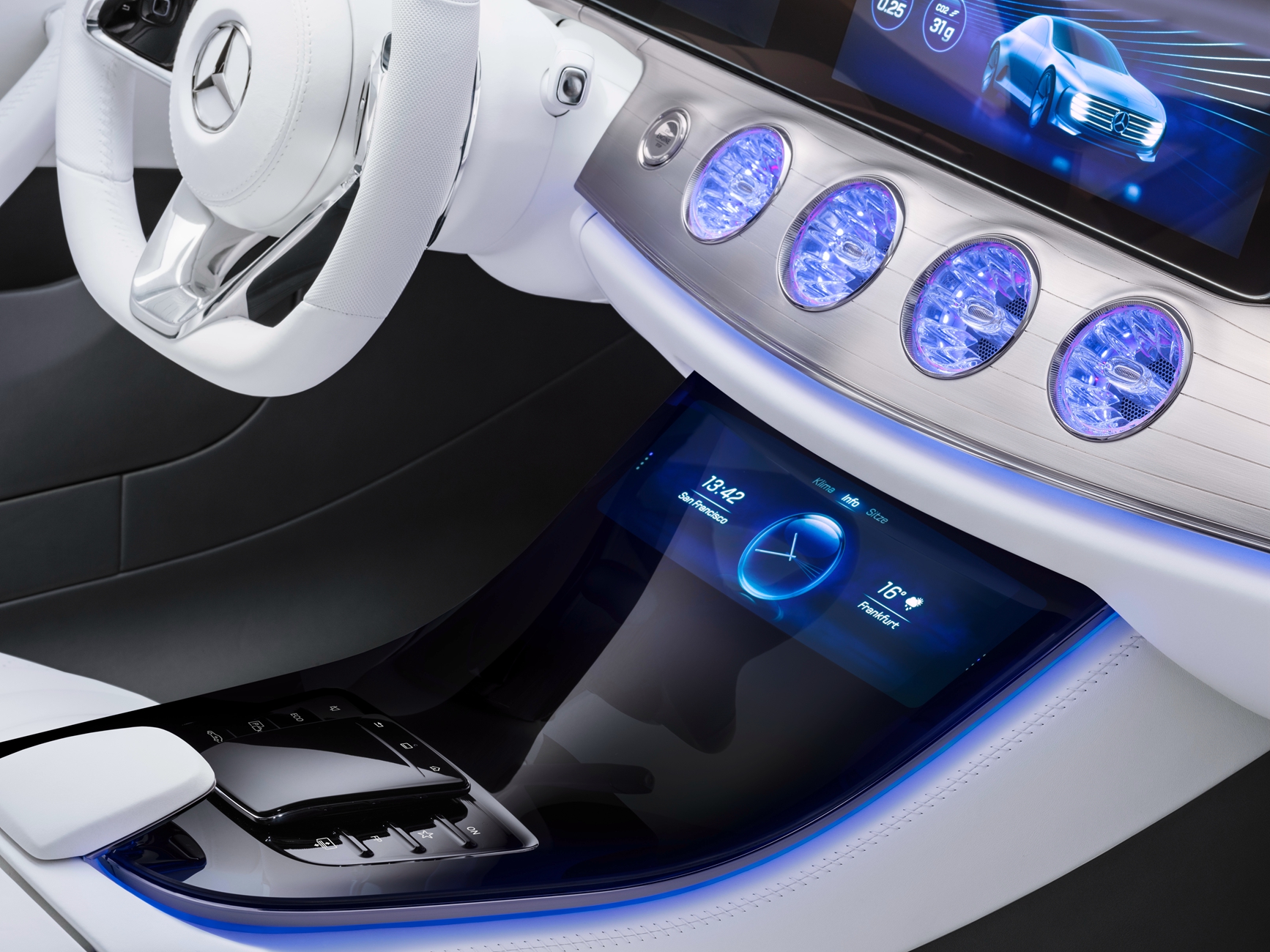 总输出为205 kW (275 hp)的汽油机-插电式混合动力系统可让这辆概念车的电子限速最高达到250 km/h (155 mph)。空气动力模式下的全电动里程为66 km (41 英里),二氧化碳排放量为28g/km。在车身较短的“原设计模式”下,里程为62km (38 英里),二氧化碳排放量为31 g/km。
总输出为205 kW (275 hp)的汽油机-插电式混合动力系统可让这辆概念车的电子限速最高达到250 km/h (155 mph)。空气动力模式下的全电动里程为66 km (41 英里),二氧化碳排放量为28g/km。在车身较短的“原设计模式”下,里程为62km (38 英里),二氧化碳排放量为31 g/km。 ConceptIAA的主动空气动力设计的拖曳系数为0.19。在尾端,由碳纤维强化塑料(CFRP)制作而成的8个组件可将车身延长至多390mm (15.4 英寸),显著减小车身后方的滞后流与拖曳。
ConceptIAA的主动空气动力设计的拖曳系数为0.19。在尾端,由碳纤维强化塑料(CFRP)制作而成的8个组件可将车身延长至多390mm (15.4 英寸),显著减小车身后方的滞后流与拖曳。 其他空气动力学的优化设计包括:适应车外气流的车窗,用蓝色LED触屏代替车门把手,降低底盘(离地间隙100mm)等。
其他空气动力学的优化设计包括:适应车外气流的车窗,用蓝色LED触屏代替车门把手,降低底盘(离地间隙100mm)等。 主动轮缘可将翘弯度从50 mm (2.0 英寸)改变成0,也就是将五幅轮改变成圆形盘轮。
主动轮缘可将翘弯度从50 mm (2.0 英寸)改变成0,也就是将五幅轮改变成圆形盘轮。 内饰设计采用了“基于接触式”的操作原则。中控台是一个曲面玻璃结构,内部整合了一个接触式显示屏。
内饰设计采用了“基于接触式”的操作原则。中控台是一个曲面玻璃结构,内部整合了一个接触式显示屏。
在2015年法兰克福车展的5场全球首秀中,梅赛德斯奔驰向观众展示了智能空气动力概念车(Concept IAA),这家德国汽车制造商将其称为“数字变形金刚”。戴姆勒管理委员会主席兼梅赛德斯奔驰总裁Dieter Zetsche表示,这辆概念车是梅赛德斯奔驰专为展示其在汽车研发生产的数字化方面的成就而设计的。
“Concept IAA可以证明,在梅赛德斯奔驰,真实世界与虚拟世界正在不断融合,” Zetsche在法兰克福车展的概念车发布会上表示。“Concept IAA的开发速度比过去任何一款概念车都要快。以前要花上一年半左右,但现在随着数字化技术的发展,我们在10个月不到的时间里就完成了开发工作。”
这辆四门轿跑总长为5040 mm (198.4 in)——在“空气动力模式”(详见下文)下,总长为5430 mm (213.8 英寸),宽度为1995 mm (78.5 英寸) ,高度为1305 mm (51.4 英寸) 。轴距2975 mm (117.1 英寸),前后轮距分别为1710mm和1770 mm (67.3英寸和69.7 英寸)。
总输出为205 kW (275 hp)的汽油-电动插电式混合动力系统可让这辆概念车的电子限速最高达到250 km/h (155 mph)。空气动力模式下的全电动里程为66 km (41 英里),二氧化碳排放量为28 g/km。在车身较短的“设计模式”下,全电动里程为62 km (38 英里),二氧化碳排放量为31 g/km。
主动空气动力学技术
据梅赛德斯称,Concept IAA以0.19的拖曳系数打破了空气动力学性能的世界纪录。在车速为80 km/h (50 mph)左右时,车辆会通过主动改变多个空气动力配置,自动从设计模式转换至空气动力模式。
在车辆尾端,由碳纤维强化塑料(CFRP)制作而成的8个组件可将车身延长至多390 mm (15.4 英寸),显著减小车身后方的滞后流与拖曳。前保险杠上的翻板可向外延伸25 mm (1.0 英寸)并向后延伸200 mm (7.9 英寸),改善车身前端与前轮区域的气流。前保险杠上的翼片可收缩60 mm (2.4 英寸),以改善车身下方的气流。此外,主动轮缘可将翘弯度从50 mm (2.0 英寸)改变成0,也就是将五幅轮改变成圆盘轮。
如此变形后,汽车的拖曳系数从0.25降至0.19,前端总面积变为2.16 m² (23.3 ft²)。由于车顶轮廓线的下坡点变得更靠前,因此设计师们为后座上方的车身设计了两个“凸起”,从而保证后座乘客有足够的头部空间。
其他空气动力学的优化设计包括:适应车外气流的车窗,用蓝色LED触屏代替门把手,降低底盘(离地间隙100 mm)等。车身下方的嵌板可部分遮盖中央通道,上面的洞孔有助于排气系统的冷却与后桥的大面积覆层。位于前轮拱罩后方侧面排气孔内的摄像头可将图像投射在车内的多画面后视镜上,这样就无需使用外部后视镜了。
在这辆全新的C级车上,还有一个可调节的散热格栅百叶窗(气流板)可用于减少拖曳。只有当冷却要求不高的时候,散热格栅里的同轴百叶窗才会关闭,以防空气进入发动机室。接着,通过梅赛德斯的星形标志与保险杆上的冷却敞口可进行基础通风。
上述空气动力设计都是在数字气流模拟的辅助下完成的。梅赛德斯的空气动力学专家使用了约100万CPU小时才完成了气流的模拟,共做出约300个版本。其中涉及的工作量几乎相当于研发一辆成品车所需的工作量。最后在辛德尔芬根的风洞中对车辆进行细节调整。
“Concept IAA采用智能创新来解决功能与美学之间的冲突,并展示出我们在提高效率方面的众多精彩创意,” 戴姆勒管理委员会集团研究负责人、梅赛德斯奔驰汽车研发中心总裁Thomas Weber教授表示。
数字化与连接性
除了令人印象深刻的汽车动力学之外,Concept IAA还反映出了正在汽车行业中发生的“根本性技术变革”,而该变革的驱动力正是“数字化——也称工业4.0”。Zetsche表示,梅赛德斯奔驰正在将从研发到生产、市场、销售、物流和服务的一整条流程进行数字化发展。
这辆概念车的设计与空气动力造型正是不同专业部门之间数字化联网的成果。设计师采用最新的算法设计方法来处理复杂的形状,接着用快速原型等生产技术将其变为现实。
这辆概念车还装有无人驾驶与V2X通讯所需的大量传感器与模块。在车内,Concept IAA延续了S级车与S级轿跑的设计主题。梅赛德斯还称,全新的触摸式功能键预示着近未来的商务沙龙的模样。
仪表板由2块12.3英寸的屏幕并排组成,显示器以嵌装的方式安装于挡风玻璃后方。所有的玻璃元素都是粘合在一起的,连挡风玻璃和薄膜之间的最小间隙也在生产过程中用一种透明胶得到了填充。梅赛德斯表示,这不仅显著提升了玻璃的光学性能,还可以使屏幕更坚固。
中控台是一个曲面玻璃结构,内部整合了一个接触式显示屏。驾驶员可在此操作空调,调节座椅,此外不同操作菜单的进入按钮也放在这里。车身外部的空气动力装置也可在一张新菜单上进行控制。
双辐方向盘上也有触摸式操作功能:镶嵌在组件中的OFN(视觉手指导向)按钮,采用与中控台触摸板类似的盘旋式样,驾驶员可以滚动按钮来选择仪表板菜单。位于左侧的OFN按钮可以控制左侧显示仪,右侧按钮则可控制右侧显示仪。
车身饰条都是用铝合金制成的,展示车的地板铺上了皮革垫子。8个通风口都是由施华洛世奇制作,以蓝红环境灯映衬。
作者:Ryan Gehm
来源:SAE 《汽车工程杂志》
翻译:SAE 上海办公室
Mercedes' concept stresses connectivity, record-breaking aerodynamics
Among its five world premieres at the IAA (Frankfurt Motor Show) 2015, Mercedes-Benz surprised show-goers with the Concept Intelligent Aerodynamic Automobile (Concept IAA), which the German automaker also calls the “Digital Transformer.” The concept car is designed to show how far advanced Mercedes-Benz already is in the “digitalization” of automotive development and production, according to Dr. Dieter Zetsche, Chairman of the Board of Management of Daimler AG and Head of Mercedes-Benz Cars.
“The Concept IAA shows that the real and the virtual world are merging more and more at Mercedes-Benz,” said Zetsche, speaking at the concept's Frankfurt Motor Show reveal. “Never before have we developed a vehicle concept as quickly as our Concept IAA. What previously took up to one and a half years, we managed in less than 10 months thanks to digitalization.”
The four-door "coupe" is 5040 mm (198.4 in) long—5430 mm (213.8 in) long when in “aerodynamic mode” (see below)—1995 mm (78.5 in) wide, and 1305 mm (51.4 in) high. Its wheelbase measures 2975 mm (117.1 in), and the front/rear track widths are 1710 and 1770 mm (67.3 and 69.7 in), respectively.
A gasoline/electric plug-in hybrid drive with a total output of 205 kW (275 hp) provides the concept car with an electronically limited top speed of 250 km/h (155 mph). In aero mode, the vehicle manages an all-electric range of 66 km (41 mi) and emits 28 g/km of CO2. In shorter “design mode,” the range is 62 km (38 mi) and CO2 emissions are 31 g/km.
Active aerodynamics
The Concept IAA is a world record-breaker for aerodynamics, according to Mercedes, with a Cd figure of 0.19. At around 80 km/h (50 mph), the vehicle automatically switches from design mode to aerodynamic mode, changing its form with a number of active aerodynamic features.
At the rear end, eight segments made of carbon-fiber-reinforced plastic (CFRP) deploy to extend its length by up to 390 mm (15.4 in), “substantially” reducing the after-flow zone behind the vehicle and thus drag. Flaps in the front bumper extend outward by 25 mm (1.0 in) and rearward by 200 mm (7.9 in), improving airflow around the front end and the front wheel arches. The fin in the front bumper retracts by 60 mm (2.4 in) to improve flow along the underbody. In addition, active wheel rims change their cupping from 50 mm (2.0 in) to zero—from five-spoke to flat-disc wheels.
As a result of this transformation, the Cd value improves from 0.25 to 0.19. The frontal area totals 2.16 m² (23.3 ft²). Because the downward slope of the concept car’s roofline begins further toward the front, designers incorporated two “rises” over the rear seats to offer the rear passengers sufficient headroom.
Other aerodynamic optimizations include windows that fit flush on the outside, a blue LED touchpad instead of door handles, and lowering of the chassis, resulting in a ground clearance of 100 mm (3.9 in). The underbody paneling partially covers the center tunnel, with perforations to allow cooling of the exhaust system, and extensive cladding on the rear axle. Cameras in the side air outlets behind the front wheel arches project images onto the split-screen rearview mirror in the interior, making exterior mirrors unnecessary.
As on the new C-Class, an adjustable radiator grille shutter (air panel) helps to reduce drag. When only low cooling requirements apply, the concentric louvers in the radiator grille are closed to prevent air from entering into the engine compartment. Basic ventilation then occurs primarily via the Mercedes star and the cooling air opening in the bumper.
The aerodynamic features were developed with the aid of numerical flow simulation. The automaker’s aerodynamics experts used around one million CPU hours to simulate the airflow, working through around 300 variants. The work involved is roughly equivalent to that required to develop a production model, according to Mercedes. Fine-tuning then took place in the wind tunnel in Sindelfingen.
“The Concept IAA applies intelligent innovations to resolve the conflicting aims of functionality and aesthetics and shows that we still have plenty of ideas on how to achieve further improvements in efficiency,” said Prof. Dr Thomas Weber, Member of the Daimler Board of Management responsible for Group Research and Head of Mercedes-Benz Cars Development.
Digitalization and connectivity
In addition to impressive aerodynamics, the Concept IAA reflects the “fundamental technological changes” taking place in the automotive industry, for which the primary driving force is "digitalization, also known as Industry 4.0." According to Zetsche, a continuous digital process chain from research and development through production to marketing and sales, logistics, and service is already becoming a reality at Mercedes-Benz.
The design and aerodynamic shaping of the concept was aided by the digital networking of different specialist departments. Designers employed the latest algorithmic design methods to handle the complex geometries, which were turned into reality via production technologies such as rapid prototyping.
The concept car also is equipped with a large number of sensors and modules that enables autonomous driving and car-to-x communication. Inside, the Concept IAA continues the design theme of the S-Class and S-Class Coupe. New touch-based functions hint at what the interior of a business saloon might look like in the near future, Mercedes says.
The automaker worked with Silicon Valley-based Nvidia and The Foundry, a creative-software developer for visual effects and games, on the in-vehicle digital displays.
The instrument cluster consists of two 12.3-in screens positioned side by side. The displays are flush-mounted behind glass. The glass elements are all bonded, which involves filling the minimal gap between front glass and film with a transparent adhesive in the production process. This provides for substantially improved optical quality and robust screens, according to Mercedes.
The center console features a trim element of curved glass in which a touch display is integrated. This is where air-conditioning and seat-adjustment functions are operated, and where entry buttons for the different operating menus are located. The exterior aerodynamic elements can be controlled in a new menu.
The two-spoke steering wheel also incorporates touch-based operating functions: OFN (Optical Finger Navigation) buttons, embedded in the clusters in a similar hovering manner as the touchpad in the center console, allow the driver to scroll through the instrument cluster menus. The OFN button on the left controls the left-hand display, the button on the right controls the right-hand display.
Trim elements are all-aluminum, and the entire floor of the show car is covered in leather. The eight air vents have been produced by Swarovski, accented by blue and red ambient lighting.
Author: Ryan Gehm
Source: SAE Automotive Engineering Magazine
等级
打分
- 2分
- 4分
- 6分
- 8分
- 10分
平均分
